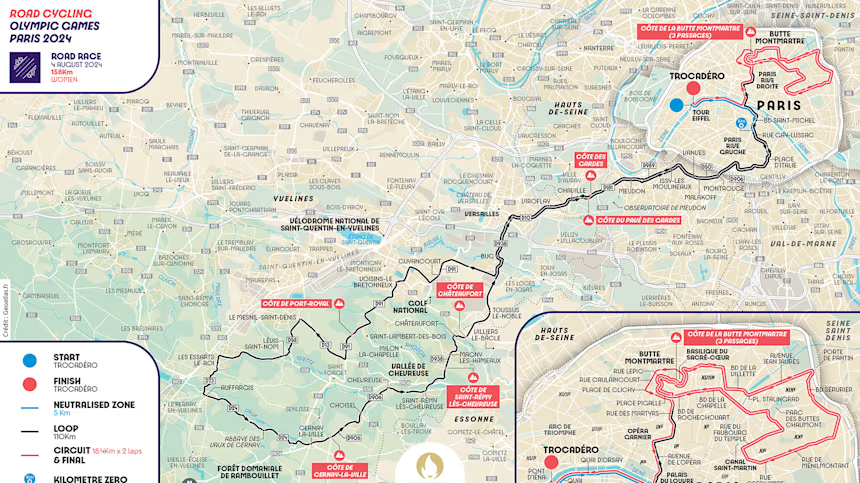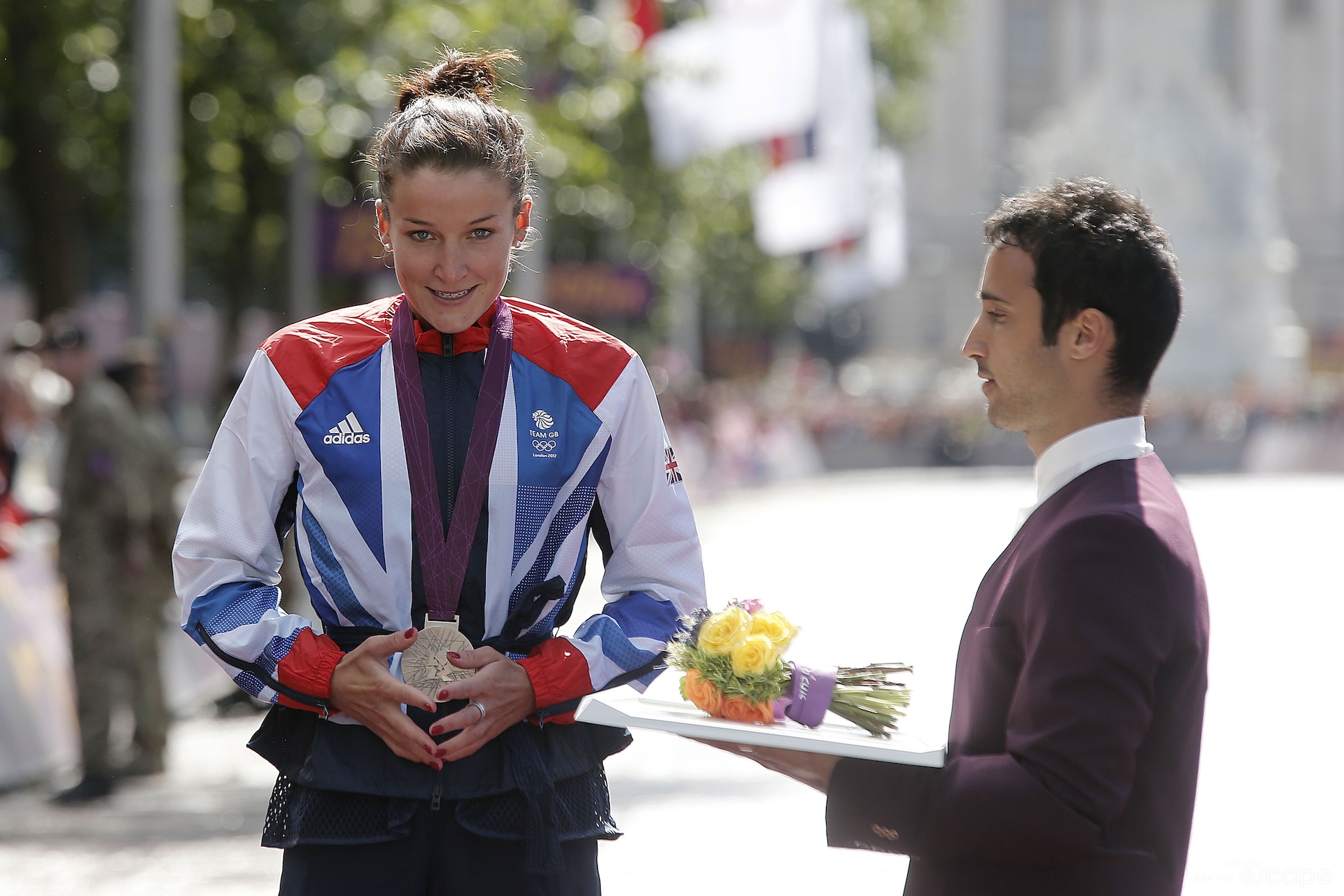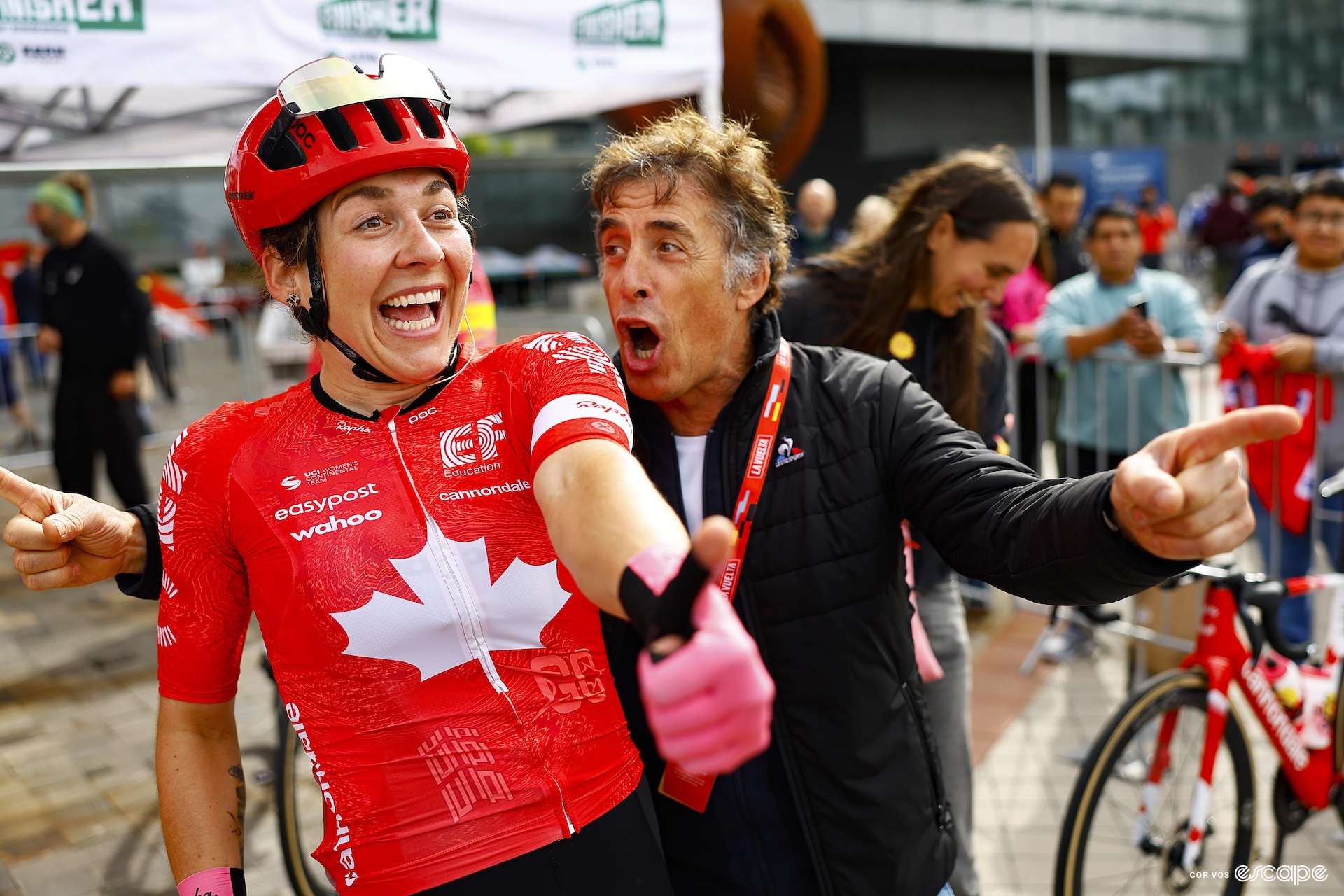Prior to 2020, when the UCI introduced a rule for minimum mandatory live coverage of Women's WorldTour racing, the only two races that were definitely broadcast live were the World Championships (which was relatively recent) and the Olympic road race. The attention on the single event every four years made it a significant one for the women, perhaps moreso than for their male counterparts.
Whenever an athlete gets to represent their home nation, instead of riding in a trade team kit, it's a special occasion. Normally it's only one or two times a year, at the World Championships and the European Championships or Pan American Championships/Oceania etc. But every four years, athletes from every sport up their game to get tapped to represent their country on an even bigger stage: the Olympic Games.

There is so much about the Games, other than the live coverage, that makes them special. All the athletes temporarily living in the village, meeting athletes of other sports and countries, the opening ceremony ... it's all quite magical. Of course, there is a darker side to the Games, the least of which is the emotional damage done to athletes not selected. On the cycling side, the International Olympic Committee's limit to the number of athletes allowed to compete means the peloton is unreasonably small, and let's not even touch the political aspect.
One thing is for sure, it's a single event that changes the whole season of cycling. It inspires riders to reach for new levels. We see women actively trying to prove to their national federations that they deserve to go to the Games and that makes the racing more exciting, and more dynamic. And, it gives us something to talk about for at least a year.
These days, with an abundance of live coverage, we are spoiled with good bike racing, but the course in Paris and the outcome of the last games are sure to deliver an event to remember. Three years ago (because of a one-year COVID-19 delay) Anna Kiesenhofer soloed to a surprise victory against a legendary Dutch team. This year, a handful of strong women will be lining up in Paris on a course that resembles a Spring Classic, all of them in the form of their lives, ready to fight for gold.
The Basics
Date: Sunday, August 4
Streaming: 🇺🇸 Peacock/NBC, 🇬🇧 BBC, 🇪🇺 Eurosport/Discovery+ 🇳🇿 Nine Network, 🇨🇦 CBC
Estimated finish time: 12:45 ET, 17:45 BST, 18:45 CET, 02:45 AEST
Type: Hilly
The Course
Compared to the last two Olympic courses, Paris is a lot more like a Classic whereas Tokyo and Rio de Janeiro were more for the climbers. There are nine categorized climbs in total, with a few uncategorized lumps in between, making for pretty consistent up and down over the 158 km distance.
The women will start at Jardins du Trocadéro before they roll out to the first climb of the day, the Côte des Gardes at 12 km into the race. The first ascent is 1.9 kilometres in length, 6% average. It's enough to spur some attacks, especially from the smaller nations which will struggle as the race drags on.
The road doesn't flatten from there but continues to pitch and dip for the next ... well, forever. The next classified climb is 26 km later, at 38 km into the race. The Côte de Port-Royal is 1 km long and averages 5%. Again, the climbing doesn't stop at the summit but continues to roll until the next classified climb at 60 km.
At 60 km there is a series of four climbs one after another. Côte de Cernay-la-Ville (1.1 kilometres at 3.9%), Côte de Saint-Rémy-lès-Chevreuse (1.3 kilometres at 6.3%), Côte de Châteaufort (900 metres at 5.7%) and Côte du Pavé des Gardes (1.3 kilometres at 6.5%). These are all within 30 km of each other, with little rest between them and are followed by the entry into Paris.
At this point, the constant up and down will be hitting some of the riders, especially those who do not regularly race in the WorldTour. The peloton for the Olympics is a combination of riders who race all the big races like Lotte Kopecky and Demi Vollering and riders from smaller nations like Awa Bamogo of Burkina Faso who has only raced two Belgian one-days (a 1.1 and a 1.2) outside of the African Games this year (that's not a dig at all; it's part of the beauty of the Olympics that we get such an international field, but it also means we have riders who aren't accustomed to the level of other riders).
Once they enter Paris there is a small bit of reprieve in the climbing, but not the chaos. The city streets will be technical, and because Paris is, you know, a busy city, there is a fair amount of road furniture to navigate. Even if it's not wet like in the time trial, the lumpy, potholed urban roads that change from pavement to cobbles and back will favor the best bike handlers.
The peloton will then ride onto the 18.4 km Montmartre circuit that will finish the race. They complete three laps of the circuit that contains one classified climb and two non-classified climbs. It's similar to the Glasgow World Championships, but not quite as hard.

Montmartre is going to be chaos, with a few fast and tricky turns off the descents and into climbs. It's going to really cut down the list of contenders because those who are strong enough to make it over the climbs will have to also follow attacks from the strongest nations and make it through the treacherous city streets.
Côte de la Butte Montmartre, the only classified climb on the circuit, is 1 km long at 6.5% but is extremely narrow. The corner off this descent is the most technical of the course,
Once the riders in front come off the final Butte ascent they have a final 9.5 km to ride to the finish.

The Contenders
Top-tier favourites
As the current World Champion, who won on a relatively similar course, and with the incredible form she displayed at the Giro d'Italia Women Lotte Kopecky is the overwhelming favourite to win gold in Paris. The Belgian woman will have a team of the maximum amount of riders – four – all fully committed to helping her win, as they did in Glasgow. It's hard to look past her because it will be near impossible for anyone to shake her and if it's a reduced group there are very few who can outsprint her. Anyone who wants to beat her will have to bring a stronger sprinter to the line, but each team with a strong sprinter also has a similar rider to Kopecky they will want to see win this race.

For example, Italy. They will come into the race with former world champion Elisa Balsamo, who can, when she is in form, best Kopecky in a sprint. However, Balsamo had to leave the Giro early due to an infection and is working her way back to form after a crash at Vuelta a Burgos. So, unless she's had the smoothest couple weeks of her life, she probably won't make it to the Paris circuits to challenge Kopecky.
The obvious team leader for Italy is Elisa Longo Borghini. The two-time Olympic bronze medalist proved at the Giro that she is in the form of her life. She won the Tour of Flanders earlier in the season thanks to some fantastic teamwork, which the Italian team can definitely try to replicate but there probably won't be a section of the Paris Olympic course half the peloton has to walk.

To shake both Kopecky and the Dutch team will be a tall task for the Italians, but the Olympic road race is always a bit weird. And after two bronze medals, and the year she's had, a gold would be the icing on the best cake ever if Longo Borghini won.
You may be wondering why a few strong Italian riders were left off the Olympic team. Chiara Consonni, who just won a stage of the Giro, and Letizia Paternoster who has had a breakthrough season on the road are both focusing on the track in Paris and opted out of the road race in favour of Silvia Persico and Elena Cecchini. Cecchini is a particularly interesting pick. She often rides in a support role at SD Worx-Protime and will be a super important asset to Longo Borghini and the rest of the Italian team.
As one might expect the Dutch team is stacked. They have three possible winners Demi Vollering, Marianne Vos and Lorena Wiebes: Vollering for the attacks/selections, Vos for any reduced sprint, and Wiebes for a bigger sprint. Now, therein lies the problem for the Dutch team. Vos and Wiebes are very similar, which means they are the only team with a built-in leadout, but would they be able to designate who works for who? It will be Vos' fifth Games. She won previously in London in 2012, and she's shown some good form this year. Her last race other than Dutch nationals was early June's Volta Catalunya where she won one stage and the overall. But Wiebes has been nearly unstoppable this year, and based on some of her performances the climbs in Paris will not shake her. If Wiebes is in the group, she is as sure a win as you can have.

Vollering will want to go on the attack, but she will be marked. The race would have to be really hard for her to be able to take the win. Again, other than nationals and the Olympic TT (she finished fifth), she hasn't raced since mid-June's Tour de Suisse. She won that event, but instead of heading to the Giro's she's been off preparing for the Olympics and the upcoming Tour de France Femmes avec Zwift.
The three Dutch superstars will have the support of Ellen van Dijk, who would also be an outside favourite to win gold but more likely will be riding support. Van Dijk had her eyes on the time trial but fell short, finishing 11th. According to power tests done by the Dutch federation prior to the Olympics Van Dijk is on form, and her performance in the time trial had a lot to do with the conditions – on a rain-slick course, she said she was afraid to fall and risk re-injury. Her result will only add fuel to the fire come the road race.
The second-tier favourites
It's not that the following riders are less capable of winning the race, but when it comes to the strength of the team – which we know is important in cycling and will be important on this course in particular – some nations with one heavy favourite only qualified for two- or three-rider teams. Italy, the Netherlands and Belgium all have four riders, so not only do they have one (or three) favourites to win, but they also have the riders to back them. A bunch of nations will be coming in with top riders and only two riders to support them. That's just the way the Olympics is.
Australia qualified for only three spots this year. They had four in both Tokyo and Rio de Janeiro, and the smaller team was a blow, especially because they have a few riders performing super well at the moment. Their small but mighty team is still notable. Grace Brown, winner of Liège-Bastogne-Liège this spring, targeted the time trial like Van Dijk and walked away with a gold medal. Another gold in the road race would be a stretch, although not out of the question; regardless she will be a critical member of the Aussie team. National champ Ruby Roseman-Gannon is their leader should the race end in a sprint or even a reduced sprint but they also have an outside bet, Lauretta Hanson.
Hanson is another always-domestique, but unlike Cecchini, there isn't as clear an option for Australia as there is for Italy. All three of Australia's riders are on the same level in terms of likelihood to win (maybe Roseman-Gannon and Brown are one step above Hanson but that's purely based on the fact that Hanson has gotten exactly one opportunity to ride for herself in the last two years). Strength-wise, and ability-wise, they are nearly equal. That makes their planning for tactics pretty exciting.

There are two other teams of four in the race, but the depth for both Switzerland and Great Britain isn't as prevalent as the Netherlands and Italy. GB has one top favourite in Pfeiffer Georgi, the national champion and second-place finisher at Paris-Roubiax Femmes this year. Georgi is solid at the terrain the race will cover in Paris and has a bit of a kick in her. She's stepped away from racing for the last month to prepare for the Games specifically. They also have previous silver medalist Lizzie Deignan who has spent a lot of this year in a support role. It's unclear if Deignan has the legs for a result, but it hardly matters when you have a rider of that experience on your team. What she may lack in form, she makes up for tenfold in knowledge. Not every team has a leader like Deignan.
The other two riders, Anna Henderson and Anna Morris, are a bit unknown. Henderson is very strong, and would any other year be a favourite one step below Georgi, but this has been a year of bad luck for the Visma-Lease a Bike rider. First, she crashed at Setmana Valenciana in February and broke her collarbone, only to come back to racing and finish 11th at Amstel Gold Race and 14th at Liège-Bastogne-Liège. Things were looking up only for Henderson to crash a week later at the Vuelta España Femenina and break her collarbone again. She returned for the Tour of Britain where she finished second overall, and then the National Championships where she won the time trial and finished second in the road race. Those are some pretty wild results for someone who broke her collarbone twice before June. Finally, Henderson rode to silver in the Olympic time trial just a week before the road race, so it's safe to say the form is there, but just unclear how it will translate to a road race-style effort.
Switzerland was going in with an incredibly strong team until second at the Worlds in Glasgow and gold medal hopeful for the Olympic time trial Marlen Reusser announced she would not race in Paris. The silver medalist in the time trial in Tokyo has been suffering from illness a lot this year, on top of a heavy crash at the Tour of Flanders, and said on her Instagram she had been diagnosed with post-infectious syndrome caused by a viral infection.
No Reusser is a blow to the Swiss team, and without her, Elisa Chabbey would be the next favourite but the former champion crashed at the Giro and fractured a bone in her foot. As of writing, she will race, but her form is a bit of an unknown. She was riding super well at the Giro, and she will be able to keep training with the fracture, cycling isn't exactly weight-bearing, but any injury is a drain on the body. Next to Chabbey Noemi Rüegg is someone who could at least pull some exciting moves. She won one of the early season one-day races in Mallorca, but it would take a bit of magic for her to finish on the Olympic podium.

Like Belgium, Poland will be riding for only one person and that is Kasia Niewiadoma. The course is great for her. Hilly, slightly unpredictable, definitely chaotic. She missed the Glasgow worlds due to illness, but she came into this season on great form, finishing second at the Tour of Flanders shortly before she won La Flèche Wallonne. Like so many others, she has stepped away from racing to prepare for the Games and for the Tour de France Femmes, but she is one who usually comes out of a break from the peloton flying.
Outside favourites
The French team of three is strong even before you factor in that they will be racing on home soil for the Olympics. It is impossible to explain the magnitude of such a feeling. For Audrey Cordon-Ragot it will mean everything, although the ITT national champion had a better shot at a result in the time trial. Juliette Labous had a decent Giro, but has had a slower season than last year where she finished second at the Italian "Grand Tour." They will, without question, be on the attack displaying the French flag regardless of form.

Both Cecilie Uttrup Ludwig and Emma Norsgaard could do well on this course for Denmark. Norsgaard has been working on her ability to get over climbs like we will see in Paris and still have a strong finish, and Uttrup is an incredibly strong rider on most terrain. Uttrup has been working her way back to form after a nasty crash at Omloop Het Nieuwsblad and her third-place finish on a stage of the Giro recently shows she's on the up. But she's had a lot of ground to cover, having been out of racing for much of the year. However, she was third in Glasgow and will love the atmosphere of the race.
Speaking of atmosphere, no one loves the attention an athlete attacks more than Alison Jackson (in the best way). The Paris-Roubaix Femmes winner has high hopes for the Games and is a rider who thrives on chaos. That the race doesn't have radios plays into the hands of the Canadian rider, who knows how to read a race with the best of them. Her desire to make the race exciting delivered her a Paris-Roubaix win, and could absolutely land her on the podium in Paris. Jackson's teammate Olivia Baril is having an incredible season, and the two of them together could have some serious fun.

Normally Liane Lippert of Germany would be a favourite, but she's had a really slow start to the year due to an offseason injury. She showed some terrific form at the Giro, winning a stage from a late-race breakaway. If the form continues, she will be up there. Her teammate Franziska Koch was looking very strong at the Giro as well.
Like Canada, New Zealand will come into the race with only two riders. Kim Cadzow, who finished sixth after being in the breakaway at Liège-Bastogne-Liège and Niamh Fisher-Black. Fisher-Black just won a stage of the Giro and will be New Zealand's top rider in Paris, her experience in the peloton will come in handy in Paris.
Finally, for the USA, Chloe Dygert has only raced on the road three times this year, all early-season Belgian Classics. But that's not saying much. She only raced a handful of times in Europe before she won a stage of the RideLondon Classic last year. She will be targeting the time trial, but since it's before the road race there's a chance she will want to get up in the action in the road race as well. However, she is also racing the team pursuit on the track which is only a few days later. So maybe she will want to tamper her efforts. Kristen Faulkner, who had a tumultuous run-in to the Olympics, has a point to prove. She is incredibly strong but may struggle on the technical city streets. She is also down to race the team pursuit and has said that event, where the Americans are strong medal contenders, is her main focus, but she's the best bet for the Americans on the road.
Check here for a full startlist for the women's Olympic road race in Paris.
Escape Collective star ratings
⭐️⭐️⭐️⭐️⭐️: Lotte Kopecky, Lorena Wiebes
⭐️⭐️⭐️⭐️: Marianne Vos, Demi Vollering, Elisa Longo Borghini
⭐️⭐️⭐️: Kasia Niewiadoma, Pfeiffer Georgi
⭐️⭐️: Cecilie Uttrup Ludwig, Kristen Faulkner
⭐️: Grace Brown, Alison Jackson, Emma Norsgaard, Liane Lippert, Chloe Dygert
💛: Lizzie Deignan, Lauretta Hanson
Did we do a good job with this story?




